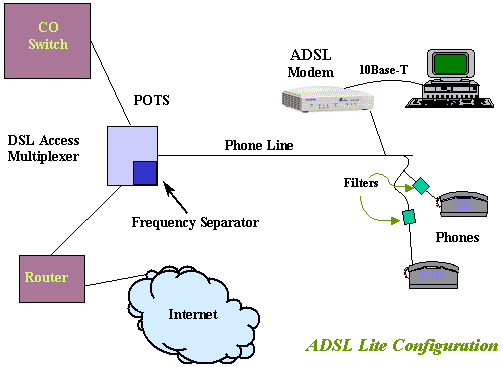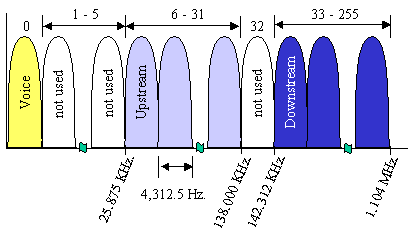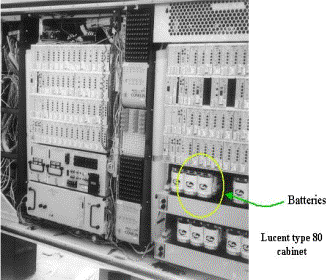|
Introduction
The term xDSL is used interchangeably
with the acronym DSL to describe the variations of the Digital
Subscriber Loop (DSL) technology. Some of the most common variations
are: ADSL, SDSL, and VDSL. They all fall into one of two categories:
asymmetric DSL and symmetric DSL with the term symmetric referring
to the upstream vs. downstream data rates.
ADSL Technology
The acronym
ADSL stands for Asymmetrical Digital Subscriber Loop and this
technology uses your existing telephone line to transmit data
between the Central Office and your computer. The major features
of ADSL are:
-
It doesn't tie up the phone line. Both analog
phone conversations and high-speed data transmission can occur
simultaneously.
-
The data path is "always on", no dial-up is required.
-
The copper wire infrastructure is very reliable.
-
The Telco service
provider has experience maintaining a high reliability network.
There are two types of ADSL systems in
use a "full rate" system and a "lite" system. Generally, the ADSL
lite system is used for residential service and Figure 1 shows
the major components for this type of system.

Figure 1. Residential Service ADSL system
In the ADSL lite system, sharing of the
same wire for voice and data is possible because the system uses
different frequencies for each service. The lower frequencies,
used for telephone service are below 4,000 Hz. and all the phones
need to have a filters so that these phones don't cause interference
with the higher frequencies being used by the ADSL modem.
The opposite end of the wire appears
at the telephone Central Office. There is a frequency splitter
that separates the voice signal and sends it the voice switch
in the normal way. The data signal is sent to a unit called a
DSL Access Multiplexer (DSLAM) that combines data from many ADSL
modems and forwards them to the Internet.
A standard voice signal on your telephone
line uses frequencies between 300 Hz. to 4,000 Hz. The phone line
can actually handle higher frequencies than that and these and
these higher frequencies are used to handle the upstream and downstream
data between the DSLAM and the ADSL modem. This is shown graphically
in Figure 2.

Figure 2. Frequency usage for an ADSL system
The ADSL Technology
ADSL is built upon the Discrete Multi-Tone
(DMT) technology. DMT divides the frequency spectrum available
on the copper wire into 256 sub-frequencies from 0 Hz to 1.1 MHz.
The first 5 sub-channels are not used and reserved for the voice
signal.
Each of the sub-frequencies is independently
modulated using a QAM modulator. Depending on the quality of the
signal in each sub-frequency, a different number of bits are able
to be sent. If the Signal to Noise Ratio (SNR), a measure of the
channel quality, was very good, many bits could be sent in that
channel every second.. Should the SNR be very poor, fewer bits
would be sent.

Figure 3. The frequency range is broken into 256 sub-frequencies
The flexibility of the technology allows
for very good optimization of the transmission medium. Should
a strong signal interference occur (radio station), then that
frequency band might be total dropped from usage. It is also constantly
optimizing its transmission to a changing environment.
Limitations of ADSL
ADSL service is limited to about 15,000
ft. In many cities, most residences are within that distance from
the telephone central office. It is easy to offer ADSL to this
type of customer since the DSLAM can be housed in the same building
as the Voice Switch. Power, cooling, and maintenance are also
provided by the same facility.
In many suburban and rural areas, telephone
service is often beyond the 15,000-foot limitation. Often times
these areas are served by something called a Digital Loop Carrier
(DLC). The DLC is a box located in an area that brings together
many telephone lines and combines them into a high speed digital
channel. That channel can be over an optical fiber or high capacity
copper wire. These DLC boxes have their own local power and emergency
power.
The presence
of the DLC box have caused major problems in the deployment of
the ADSL service.
-
The ADSL signal cannot pass through the DLC conversion.
An ADSL termination device similar to the DSLAM in the Central
Office must be put into the DLC cabinet.
-
Many DLC cabinets are full or nearly full of
equipment for telephone service. Often times this requires
another box be installed at the same location. This causes
delays in providing the service.
-
If only a few people in that area of the DLC
cabinet take the ADSL service, the cost per subscriber is
very high.

Figure 4. A typical DLC cabinet
Other DSL Technologies
There are a number of DSL technologies.
A quick summary of these technologies is shown in the following
table:
Table 1. List of the Major xDSL Technologies
|
Name
|
Standard
|
Speed
|
Mode
|
Distance
|
|
ADSL (G.dmt)
|
G.992.1
|
1.5 - 9 Mbps
16 - 640 Kbps
|
Downstream
Upstream
|
18,000 ft
(12,000 ft.) for max
speed
|
|
(G.lite)
|
G.992.2
|
1 Mbps
128 Kbps
|
Downstream
Upstream
|
18,000 ft
|
|
HDSL
|
|
1.54 Mb/s
|
Two pair
|
15,000 ft.
|
|
HDSL-II
|
G.991.1
|
1.54 Mb/s
|
Single pair
|
15,000 ft.
|
|
IDSL
|
|
144 Kbps
|
Single Pair
|
18,000 ft.
|
|
RADSL
|
|
1 - 7 Mbps
128 Kbps - 1.5 Mbps
|
Downstream
Upstream
|
18,000 ft.
|
|
SDSL
|
G.991.2
|
1.54 Mb/s
|
Duplex
|
10,000 ft.
|
|
VDSL
|
G.993.1
|
13 - 52 Mbps
1.5 - 2.3 Mbps
|
Downstream
Upstream
|
1,000 - 4,000 ft depending
on speed
|
A short description of each of these
technologies is provided below.
HDSL High Bit-Rate Digital Subscriber Line
HDSL is the most established of the
DSL technologies. It is symmetric, with a maximum 1.5 megabits
per second traveling both ways over two copper phone lines, or
2 Mbps over three phone lines. It is often utilized as an alternative
to T1 connections. (A T1 connection is a high-speed, dedicated
telephone line offering 1.54 megabits per second of data transfer.)
HDSL is limited to a distance of 12,000 - 15,000 feet. This range
can be extended with the use of signal repeaters.
HDSL II - High Bit-Rate Digital Subscriber
Line II offers the same performance as HDSL, but over a single
phone line.
SDSL - Symmetric Digital Subscriber Line
SDSL offers a symmetric transmission
of data at the same speed as HDSL, with two important differences:
it can be done using only one phone line and the user must be
no more than 10,000 feet from the phone company's central office.
SDSL is the forerunner to HDSL II.
VDSL - Very High Bit-Rate Digital Subscriber Line
VDSL is the fastest DSL technology, with
rates from 13 to 52 megabits per second downstream and 1.5 to
2.3 megabits per second upstream. The tradeoff for this speed
is that the maximum distance from the central office to the user
must be between 1,000 and 4,500 feet. The provider can extend
this distance by setting up a network interface within 4,500 feet
of the user's location and connecting it to the central office
with fiber optic cable.
IDSL - ISDN Digital Subscriber Line
IDSL is a hybrid of DSL and ISDN technologies.
It uses the same data encoding technique of ISDN devices and delivers
up to 144 kilobits per second bandwidth. The difference between
the two is that IDSL bypasses the congested phone network and
uses the data network instead. Also, there is no call setup delay
like you experience with ISDN connections.
RADSL - Rate Adaptive Asymmetric Digital Subscriber
Line
RADSL operates at the same bandwidths
as ADSL - up to 7 megabits per second downstream and up to 1.5
megabits per second upstream, with the additional capability of
adjusting bandwidth to the quality of the phone line during the
data transmission, instead of just once at the start of the connection.
More Information
The DSL Forum, an alliance of companies
advancing ADSL technology, provides a useful site at: www.adsl.com
.
Related seminars:
 Cable Modems vs. ADSL, Technology, Applications and Myths
- Learn about these two types of broadband delivery systems. This
seminar provides an overview of the technologies, where they shine
and the the truth behind the myths being spread by these fierce
competitors.
Cable Modems vs. ADSL, Technology, Applications and Myths
- Learn about these two types of broadband delivery systems. This
seminar provides an overview of the technologies, where they shine
and the the truth behind the myths being spread by these fierce
competitors.
 Cable Modem - The Cable Modem standard for the US is
DOCSIS (Data Over Cable System Interface Specification). This
series looks provides an overview of the workings of a cable TV
system, the messages that control the system and the modulation
technology.
Cable Modem - The Cable Modem standard for the US is
DOCSIS (Data Over Cable System Interface Specification). This
series looks provides an overview of the workings of a cable TV
system, the messages that control the system and the modulation
technology.
In Summary:
-
ADSL provides a reliable way to provide broadband
services to customers..
-
ADSL automatically adjusts its frequencies to
avoid interference from other signals.
-
Digital Loop Carrier cabinets have slowed deployment
of the ADSL technology.
-
There are many forms
of DSL technology.
|

